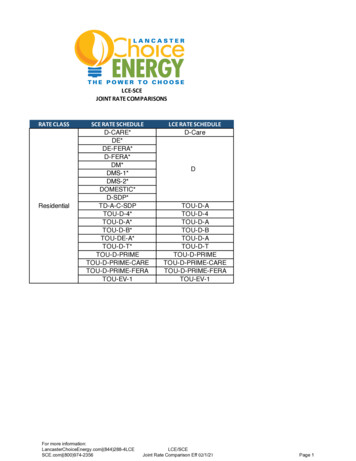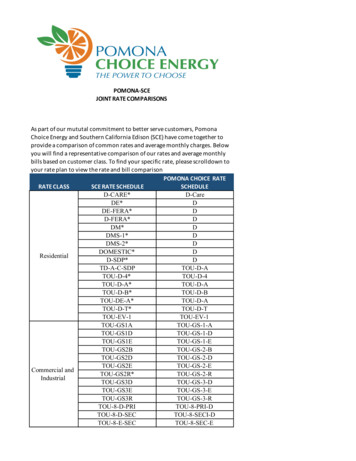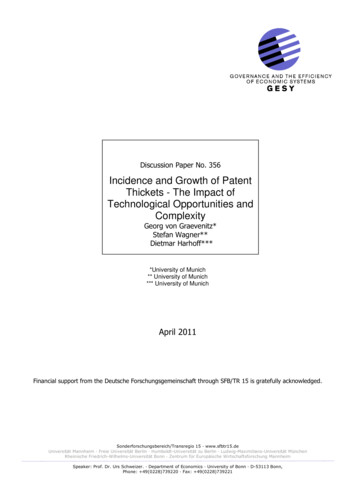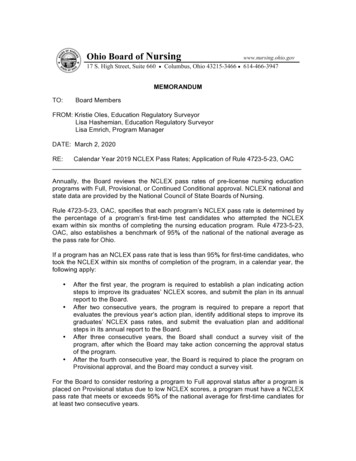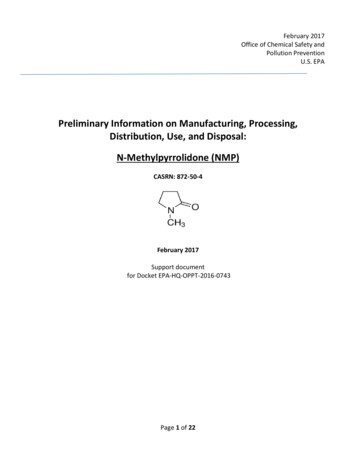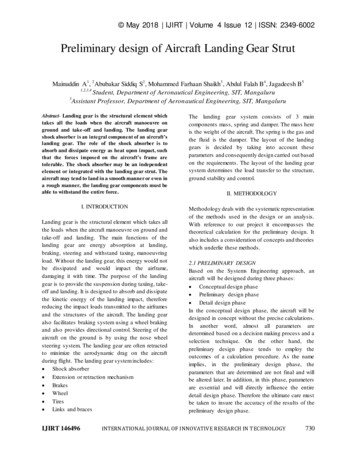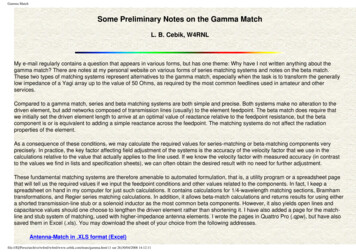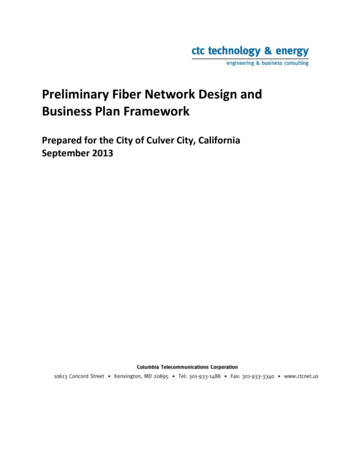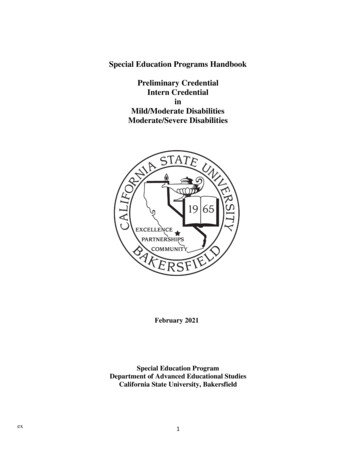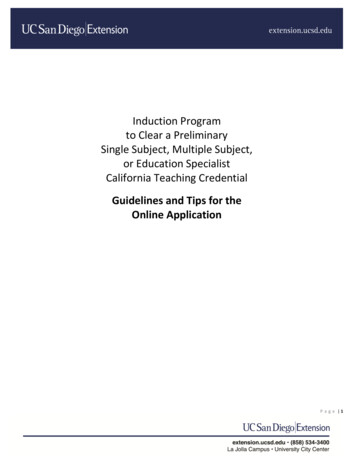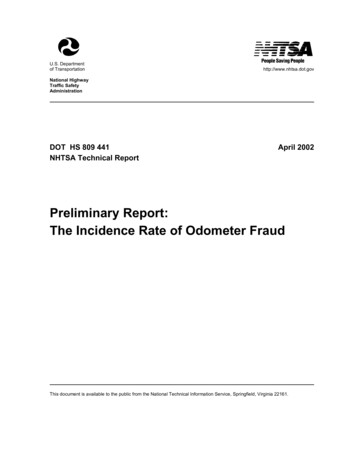
Transcription
U.S. Departmentof Transportationhttp://www.nhtsa.dot.govNational HighwayTraffic SafetyAdministrationDOT HS 809 441NHTSA Technical ReportApril 2002Preliminary Report:The Incidence Rate of Odometer FraudThis document is available to the public from the National Technical Information Service, Springfield, Virginia 22161.
The United States Government does not endorse products or manufacturers. Trade ormanufacturers’ names appear only because they are considered essential to the object of thisreport.
TABLE OF CONTENTSTABLE OF CONTENTS.IIIEXECUTIVE SUMMARY .VCHAPTER 1 .1INTRODUCTION AND BACKGROUND.1RESULTS OF EARLIER STUDIES .3CHAPTER 2 .5THE INCIDENCE RATE OF ODOMETER ROLLBACK IN PASSENGER VEHICLES.5NATIONAL SAMPLE .5CARFAX .6RESULTS.10LIKELIHOOD OF ROLLBACK DURING THE FIRST 11 YEARS OF A VEHICLE S LIFE.18CONFIDENCE BOUNDS.31CHAPTER 3 .35THE INCREASED PRICE CONSUMERS PAY FOR PASSENGER VEHICLES DUE TOODOMETER ROLLBACK.35N.A.D.A. OFFICIAL USED CAR GUIDE .35METHOD FOR AN INITIAL ESTIMATE.37RESULTS.43ADJUSTMENT OF THE INITIAL ESTIMATE BASED ON KNOWN ROLLBACKS .47CONFIDENCE BOUNDS.48CHAPTER 4 .51STATE EFFORTS TO DETER ODOMETER FRAUD .51RESULTS.52SUMMARY.65CHAPTER 5 .67FEDERAL EFFORTS TO DETER ODOMETER FRAUD.67ODOMETER FRAUD STAFF.67FEDERAL INVESTIGATIONS.68ASSISTANCE TO STATES AND COMMUNITIES.70ASSISTANCE TO THE PUBLIC .71SUMMARY.72RECOMMENDATIONS.75iii
iv
EXECUTIVE SUMMARYOdometer fraud is the illegal practice of rolling back odometers to make it appear that vehicleshave lower mileage than they actually do. This has historically been considered a significantproblem for the American consumer. While any vehicle sold on the used car market could havebeen the object of odometer tampering, the problem has been considered to be most prevalentamong late model vehicles which have accumulated high mileage in a relatively short period oftime. Vehicles in fleets, such as lease fleets, rental fleets, or business company fleets typicallyfall into this category. When sold on the used car market, vehicles whose odometers have beenrolled back, or "spun," can obtain artificially high prices, since a vehicle's odometer reading is akey indicator of the condition, and hence the value, of the vehicle.Consider, for example, 3-year-old cars whose odometers were rolled back from 80,000 to 30,000miles. Unwary consumers pay top dollar for such cars, believing that they are in prime condition,likely to give several years of nearly trouble-free service, and still have some resale value.Instead, they get a car with a lot of wear-and-tear, likely to experience irritating breakdowns andincur costly repairs over the next several years, and have little more than scrap value after that.If they had known the cars’ true mileage, they would, of course, not have been willing to paynearly as much for them, and probably would not have bought them at all.In order to reduce the incidence of odometer fraud, Congress has enacted several laws to prohibitodometer tampering and to protect consumers. The most recent law (Public Law 99-579) is theTruth in Mileage Act (TIMA) of 1986. It requires the transferor (seller) to disclose the vehicle smileage on the title when a vehicle s ownership is transferred. The regulations apply when avehicle is sold or leased to auto auctions, car dealerships, and individuals. The title must beprinted by a secure process, or if not printed, be set forth by a secure system, to decrease thepossibility of counterfeiting or altering titles. These provisions help create a permanent record or“paper trail” on the vehicle s title. In addition, the TIMA requires that auction companiesestablish and maintain records for at least four years following the date a vehicle is sold atauction. This provides law enforcement investigators with a better means to track the vehicle scourse from seller to consumer. The TIMA required all vehicle transfers to conform with thenew disclosure requirement on April 29, 1989, unless NHTSA granted a time extension orapproved an alternate motor vehicle mileage disclosure requirement if it was consistent with thepurposes of the new law. NHTSA granted time extensions to most states. It took some statesseveral years to comply with the new regulations. By April 18, 1994, all states were incompliance.The Congress specifically requested “a nationwide assessment of odometer fraud. This study, tobe conducted by National Highway Traffic Safety Administration s (NHTSA) Office ofPrograms and Policy, will determine the extent of used car dealer compliance with odometerdisclosure requirements and the effectiveness of state enforcement activities.” (House Report103-190 of July 27, 1993). The Government Performance and Results Act of 1993 andv
Executive Order 12866 (October 1993) also require agencies to review their existing programsand regulations from time to time. This report consists of the three components:(1) estimation of the incidence rate of odometer fraud and economic loss due to itsinflation of the purchase price of passenger vehicles,(2) a survey of the states efforts to combat odometer fraud,(3) an assessment of the Federal efforts to investigate and deter odometer fraud.However, this report is not an evaluation of the effectiveness of the Truth in Mileage Act in thatit does not estimate how well the regulations reduced odometer rollback or helped catchcriminals. Data to estimate rollback rates before the Truth in Mileage Act were not available.Thus, a typical evaluation, comparing the odometer rollback rate before the regulation to the rateafter the regulation took effect, was not possible. This report estimates the current incidence ofodometer fraud.The report estimates the probability of an odometer rollback during the first 11 years of apassenger vehicle s life to the extent it can be detected in title transfer and other odometerreading data. The analysis uses a nationally representative sample of 10,000 passenger cars,pickup trucks, vans and sport utility vehicles and a national vehicle history database (Carfax) toidentify vehicles with odometer discrepancies that suggest rollback - i.e., odometer readings ontwo separate occasions, and the later reading has the lower mileage. These data are used only forstatistical purposes to estimate rollback rates for the overall vehicle population. No claim ismade that these data alone, without a follow-up investigation, are sufficient to prove or disprovefraud in individual vehicle cases.The rate of odometer fraud over the life of the vehicle is 3.47 percent (confidence bounds from2.68 to 4.26 percent). That is a 3.47 percent chance that a vehicle would have its odometerrolled back at any point during the first 11 years of its life. This rate includes, but is not limitedto the types of rollback that can be detected in title histories such as Carfax. An odometer maybe rolled back and not identified as such in Carfax as long as the subsequent mileage is not lowerthan the previous mileage. This could happen in several ways. The most common way is toalter the mileage on the title to reflect the rolled-back odometer reading that is lower than thetrue mileage, although higher than any previously titled mileage. The incidence of such“hidden” rollbacks was estimated with a case-by-case analysis of a large file of known rollbacks.There are approximately 452,000 cases of odometer fraud per year in the United States based onthe fraud rate and number of registered vehicles by vehicle age.This study also estimates the increased price consumers pay for odometer rollback at the timethey purchase a vehicle: the difference between the inflated prices that consumers actually paidvi
for the rolled-back vehicles and the prices they would have been willing to pay if they hadknown the true mileage. Those costs average 2,336 per case of odometer fraud. Given 452,000cases per year in the United States, that amounts to 1,056 million per year (confidence boundsfrom 737 million to 1,376 million). That sum does not include inflated financing, insuranceand tax costs; additional amounts consumers pay for vehicle repairs; other consequentialdamages; the decreased resale value due to the vehicle having an altered odometer; or the manyindirect or intangible costs of odometer fraud: time spent waiting for vehicle repairs and roadservice, consumers’ anger and frustration at being cheated and getting a car they wouldn’t havewanted, and costs of government programs to detect and deter odometer fraud.The increased cost consumers pay to purchase passenger vehicles with odometer rollback of 1,056 million per year makes odometer fraud one of the top crimes against property in theUnited States. By comparison, the Federal Bureau of Investigations estimated that in the year2000, auto theft resulted in direct losses of 2,900 million, arson 760 million, burglary 3,000million, and shoplifting 200 million.1To assess the states efforts to combat odometer fraud, a questionnaire was sent to stateDepartment of Motor Vehicle offices in October 1997. The major focus of the questionnaire wason the odometer disclosure requirements imposed on states by Federal Regulations. Forty-sixstates, the District of Columbia and Puerto Rico returned completed questionnaires. Thequestionnaires showed: Most states had to make extensive changes to meet the new odometer disclosurerequirements. Only 8 states met all the requirements before the April 29, 1989 deadline.All states met the new requirements by April 18, 1994. Although all states met the minimum Federal regulatory requirements, very few statesappeared to have a comprehensive detection program in place to identify cases ofsuspected odometer fraud. Only four states had taken all three of the following steps todetect and deter fraud: (1) routinely verify odometer readings submitted by titleapplicants, (2) alert the titling office or applicant when a vehicle is being titled with alower mileage than indicated on a previous title, and (3) keep records of odometerreadings at any time other than titling, such as at annual emissions or safety inspections. Fewer than ten states routinely notified law enforcement agencies when the odometerreading shows signs of alterations on the title being surrendered. Most applicants do not request a check of odometer reading or title history, which is aninexpensive service.1 Crimein the United States - 2000 Uniform Crime Reports, Federal Bureau of Investigations,U.S. Department of Justice, Washington, DC.vii
Almost 65 percent of the states we
This report estimates the current incidence of odometer fraud. The report estimates the probability of an odometer rollback during the first 11 years of a passenger vehicle s life to the extent it can be detected in title transfer and other odometer reading data. The analysis uses a nationally representative sample of 10,000 passenger cars,
